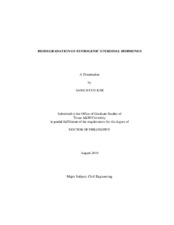| dc.contributor.advisor | Autenrieth, Robin | |
| dc.creator | Kim, Sang Hyun | |
| dc.date.accessioned | 2011-10-21T22:03:24Z | |
| dc.date.accessioned | 2011-10-22T07:09:59Z | |
| dc.date.available | 2011-10-21T22:03:24Z | |
| dc.date.available | 2011-10-22T07:09:59Z | |
| dc.date.created | 2010-08 | |
| dc.date.issued | 2011-10-21 | |
| dc.date.submitted | August 2010 | |
| dc.identifier.uri | https://hdl.handle.net/1969.1/ETD-TAMU-2010-08-8481 | |
| dc.description.abstract | Natural and synthetic estrogens are some of the most potent hormones detected in the environment. Agriculture fields often release higher concentrations of natural estrogens to the environment, but wastewater treatment plants (WWTPs) commonly release higher concentrations of synthetic estrogens. Estrogens can disrupt endocrine functions in wildlife and humans. Less attention has been paid to the fate and occurrence of estrogens in agricultural operations than WWTPs. Their fate is influenced by major mechanisms such as sorption and biodegradation. Sorption typically accounts for less than 10 percent of estrogen removal in WWTPs. However, biodegradation is a primary method for estrogen loss at high ammonia concentration in the agricultural and municipal operation. Less attention has been paid to the biodegradation kinetics of estrogens in the field application. Therefore, this dissertation focused on the occurrence of estrogens in agricultural fields and their biodegradation by a mixed culture and a pure culture. The estrogens in turkey litter amended fields might be biodegraded to some degree by turkey litter borne bacteria. The estrogen biodegradation by a mixed culture showed different mechanisms for each estrogen. E1 and E2 were easily degraded as a carbon source of the mixed culture. E3 and EE2 were favorable for cometabolic degradation by AOB. EE2 was not readily biodegraded by the mixed culture due to a steric hindrance of enzyme expression and EE2 metabolism in the ethynylgroup of EE2. The cometabolic kinetics of individual estrogen was evaluated by using a pure culture. The cometabolism of estrogen was demonstrated by a reductant model. This model appropriately estimated the cometabolic kinetics of individual estrogens. In addition, the effect of antibiotics on the hormone degradation was investigated in Sequencing Batch Reactors (SBRs). No significant difference was detected for the removal efficiency of target compounds in the SBRs in presence or absence of antibiotics (oxytetracycline and chlortetracycline) during long sludge retention time (SRT). However, the effluent organic matter (EfOM) was less decomposed with the presence of antibiotics, especially causing less degradation of the humic-like substances in EfOM. The results indicated the flux of antibiotics to WWTPs did not affect hormone degradation, but reduced the decomposition of humic-like substance. Finally, the findings from the research provide insight into how biodegradation influences estrogen removal in agricultural fields and municipal WWTPs. The models developed in this research yielded valuable predictive values for engineered systems. | en |
| dc.format.mimetype | application/pdf | |
| dc.language.iso | en_US | |
| dc.subject | Estrogen | en |
| dc.subject | biodegradation | en |
| dc.subject | effluent organic matter | en |
| dc.subject | kinetics | en |
| dc.title | Biodegradation of Estrogenic Steroidal Hormones | en |
| dc.type | Thesis | en |
| thesis.degree.department | Civil Engineering | en |
| thesis.degree.discipline | Civil Engineering | en |
| thesis.degree.grantor | Texas A&M University | en |
| thesis.degree.name | Doctor of Philosophy | en |
| thesis.degree.level | Doctoral | en |
| dc.contributor.committeeMember | Batchelor, Bill | |
| dc.contributor.committeeMember | Chu, Kung-Hui | |
| dc.contributor.committeeMember | McDonald, Thomas | |
| dc.contributor.committeeMember | Harmel, Daren | |
| dc.type.genre | thesis | en |
| dc.type.material | text | en |


